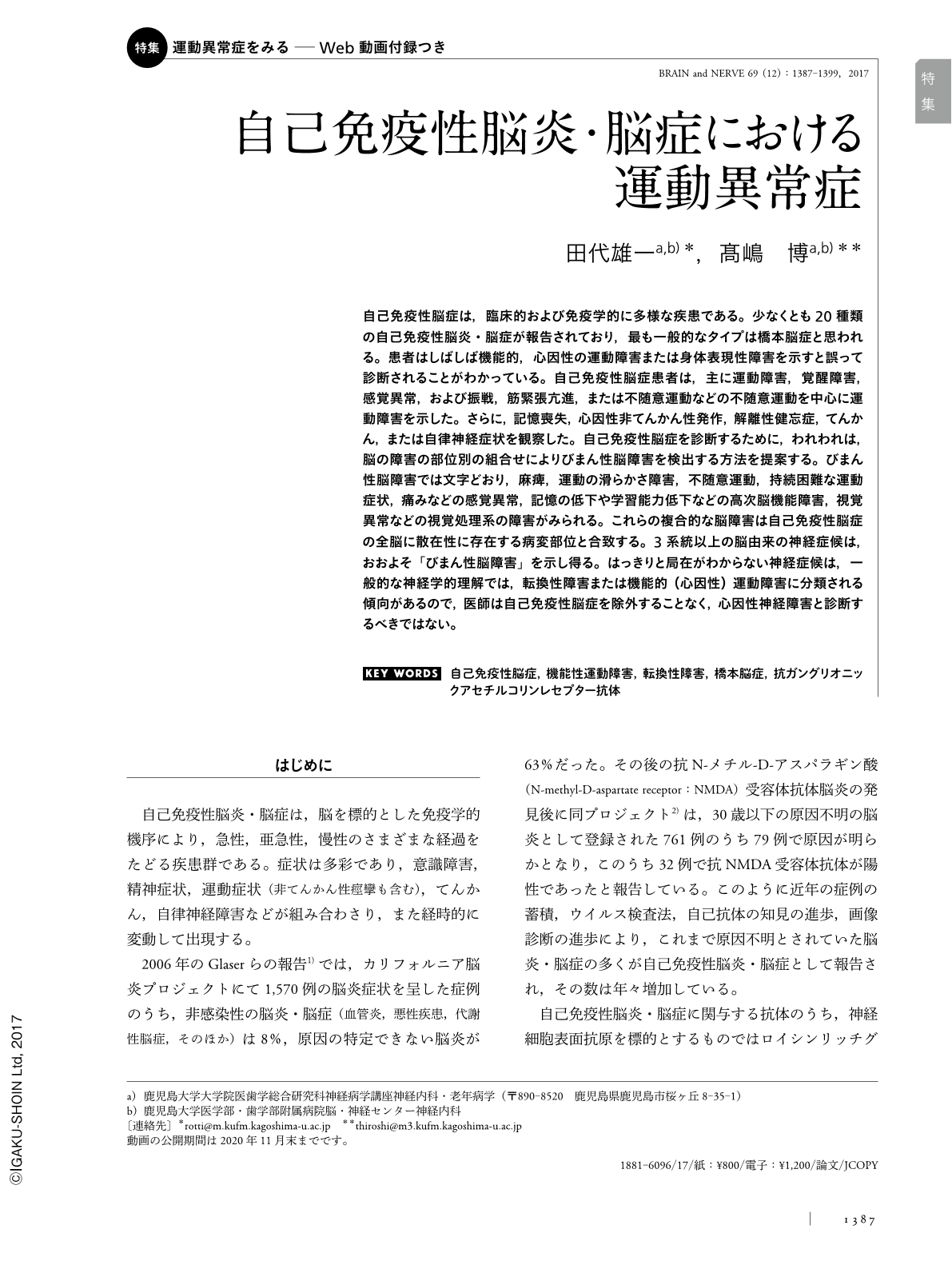Japanese
English
- 有料閲覧
- Abstract 文献概要
- 1ページ目 Look Inside
- 参考文献 Reference
自己免疫性脳症は,臨床的および免疫学的に多様な疾患である。少なくとも20種類の自己免疫性脳炎・脳症が報告されており,最も一般的なタイプは橋本脳症と思われる。患者はしばしば機能的,心因性の運動障害または身体表現性障害を示すと誤って診断されることがわかっている。自己免疫性脳症患者は,主に運動障害,覚醒障害,感覚異常,および振戦,筋緊張亢進,または不随意運動などの不随意運動を中心に運動障害を示した。さらに,記憶喪失,心因性非てんかん性発作,解離性健忘症,てんかん,または自律神経症状を観察した。自己免疫性脳症を診断するために,われわれは,脳の障害の部位別の組合せによりびまん性脳障害を検出する方法を提案する。びまん性脳障害では文字どおり,麻痺,運動の滑らかさ障害,不随意運動,持続困難な運動症状,痛みなどの感覚異常,記憶の低下や学習能力低下などの高次脳機能障害,視覚異常などの視覚処理系の障害がみられる。これらの複合的な脳障害は自己免疫性脳症の全脳に散在性に存在する病変部位と合致する。3系統以上の脳由来の神経症候は,おおよそ「びまん性脳障害」を示し得る。はっきりと局在がわからない神経症候は,一般的な神経学的理解では,転換性障害または機能的(心因性)運動障害に分類される傾向があるので,医師は自己免疫性脳症を除外することなく,心因性神経障害と診断するべきではない。
*本論文中に掲載されている二次元コード部分をクリックすると,付録動画を視聴することができます(公開期間:2020年11月末まで)。
Abstract
Autoimmune encephalopathies are clinically and immunologically heterogeneous disorders. At least 20 types of autoimmune encephalopathies have been discovered, with the most common type being Hashimoto encephalopathy. In clinical situations, we often observe that patients with autoimmune encephalopathy are misdiagnosed because they exhibit signs similar to those observed in functional psychogenic movement, conversion, or somatoform disorders. We clinically examined over 100 patients with autoimmune encephalopathy. These patients primarily demonstrated motor disturbances, mostly with give-way weakness, sensory abnormalities, and involuntary movements such as tremor entrainment, dystonia, or coarse involuntary movement. In addition, we observed memory loss, psychogenic non-epileptic seizures, epilepsy, and autonomic symptoms in our patients. To diagnose autoimmune encephalopathies, we propose that a combination of neurological symptoms indicating “diffuse brain damage” be used. “Diffuse brain damage” is a proof of several symptoms, such as give-way weakness; motor symptoms such as paralysis, smoothness disorder of exercise, involuntary movements, and difficulty to sustain; abnormal sensations such as pain, abnormal perception of various parts, and impaired vibration sensation; deterioration of higher order functions such as memory and learning ability; and impairment of the visual processing system and various visual abnormalities. As patients with autoimmune encephalitis exhibit diffuse involvement, the presence of these symptoms was entirely understandable. Over three such abnormal findings could indicate diffuse brain damage. Owing to the regular understanding in neurology, most patients tend to be diagnosed with somatoform disorders. Thus, physicians should not diagnose somatoform disorders without first excluding autoimmune encephalopathy.

Copyright © 2017, Igaku-Shoin Ltd. All rights reserved.


